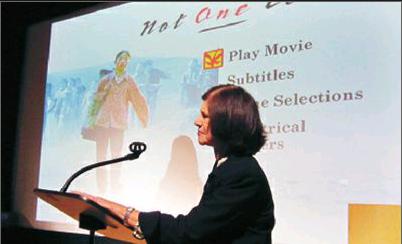World view
2015-02-05ByCorriedosh
By+Corrie+dosh

Packing more than 100 high school students into a theater to watch a subtitled foreign film would be a challenge for most educators, but as the ending scenes for the emotional drama Not One Less by acclaimed Chinese director Zhang yimou began to roll, the muffled sniffles could be heard from the young audience at the UNs theater in December 2014. The students, many of whom were learning Mandarin, were invited to the screening by International Cinema Education(ICE)—an NGO that has given more than 8,000 students the opportunity to experience foreign culture through the power of film.
The award-winning Not One Less follows the story of a young girl in rural Hebei Province who takes a job as a substitute schoolteacher in a small village. When one of her students drops out of school to search for work in the city, the young teacher tracks him down and brings him back to the village. The girls dedication to keeping all of her students in school illustrates the challenges inherent in the rural education reform which requires students to undergo nine years of compulsory education. Educators were faced with the problem of swathes of rural schoolchildren dropping out to find work.
Teaching global citizenship
For ICE founder Roberta Seret, Director of Professional English at the UN, where she teaches the English language and its related culture to diplomats, the film is an opportunity to transport New york students to rural China without a plane ticket or visa.
“Were going around the world in these films,” Seret said.
ICEs mission is to use film as a catalyst to teach high school students about global issues. Key to the success of the program is a Socratic-style approach with an emphasis on post-screening discussions with an expert. For the screening of Not One Less, Seret invited Du xiaoxue, a UN intern and New york University student, to speak with the students.
“I believe in the power of education and that hard work can create miracles,” Du said.
Du shared her own experiences as a volunteer teacher in the countryside as the students asked thoughtful and illuminating questions about economic equality, the power of selfdetermination and compassion.
Cultural exchange is “not just about learning,” Seret said. “Its about the human interaction, the human element. Being a global citizen is a way to stimulate and open your mind.”
Wang Lin, a Mandarin teacher at the Chapin School in New york, brought his students to the UN to view Not One Less and said they had been preparing with class discussions and worksheets ahead of the screening.
Film is a wonderful way to learn language, Wang said, as it engages and entertains the students with stories.
“All my students highly enjoyed the event—watching the movie followed by the discussion,” Wang told Beijing Review. “Many have told me that they learned a great deal about Chinese language and culture from this event. They told me that the movie is so touching that it will have a positive impact on their views toward the human world and the love of mankind. It was beyond my expectations that the outcome of this event has been so great and my students have really learned a lot.”
Wang said the benefits of attending the screening extended beyond learning language. He conducted a follow-up discussion with students on their return to school and some students wrote a journal in Mandarin discussing the event.
“Chinese movies are an important component of our Chinese program at the Chapin School and we will continue to let our students watch good movies like Not One Less,” Wang said.
Seret said she chose Not One Less for the human element and the theme of universal humanity that connects us all. The film showed the emotional growth of the young teacher, and the empathy demonstrated by her community in helping her find her student.
Making it happen
Seret said she came up with the idea of teaching global culture through film as a student in France. She would often attend screenings at the student film center, where various departments of the university would show movies germane to their respective fields of study. She found it an effective, and enjoyable, way of learning both language and culture.
“It was so wonderful to learn French through these movies and lectures. I thought it was so exciting, and that I would love to do this in the United States,” she said.
After the September 11 terrorist attacks in New york, Seret said she was compelled to help students in the city cope with the attacks and felt strongly that it was part of the UNs mission. She began gathering support to launch an educational film series that would help students understand global culture. A four-year grant from the Ford Foundation and other key donations paved the way to turn her dream into a reality. She launched ICE in 2003, and was given NGO status a few years later.
“I wanted to create a ‘global classroom in the UN—a meeting place where members of all countries could teach about the world and students could learn. What better classroom could exist than the UN, where ‘the world is part of its daily activities? And what better medium is there than foreign films to each young people about global affairs and human feelings?” Seret wrote in the introduction to her book, World Affairs in Foreign Films: Getting the Global Picture—a guide for teachers and students to experience 13 films set in various global hotspots.
The text offers multi-disciplinary lesson plans that examine each film through eight subjects: world history, geography, economics, civics, citizenship and government, world literature, creative writing, as well as media studies and music/art. Along with the book, Seret launched a program in 2008 called Global Voices—bringing films directly into public high schools with lectures, post-film Q&A discussions, workshops and tours of the UN building.
For the 2003 film Osama, for example, students examine the culture and history of Afghanistan with geographical maps, folklore, writing activities and class discussion. The power of the films story provides cohesion and narrative to the larger economic and political climate.
“Film is a new art that can entertain and be used for education. It can teach many things,”Seret said. “How can you separate geography and history? Economics and politics?”
Seret selects films that are “stories of the human heart” that have universal messages.
“I go to every film festival and screening I can go to,” she said. “I have students from all over the world, as well, so I ask them for recommendations.”
To engage students that have a hard time sitting through a full-length foreign film, Seret launched FILMeds, 10-minute selections of edited clips from the movies of Global voices. Each selection includes lessons in geography, history, government and human rights and questions to stimulate classroom and group discussions about a countrys geopolitical position. Thirteen schools participated in 2014.
“I cut down to the jewel, the essence of the film,” she said. “I want to keep the eight subjects and the Q&A.”
Seret has taken her program outside New york to states like Florida, where she visited Lake Wales Charter School to teach film students how to make a FILMed of their own. She targeted students in their junior year of high school, the year before they began their college application process.
“All 10 students I taught won college scholarships,” she said.
Testimonials on the ICE website show the impact the films have had on the young viewers.
“With our newly learned knowledge and our developing sense of global awareness, we can now move on into the adult world, and strive to fix the problems that plague our world,” wrote one viewer.
“I felt that these movies helped me understand better than any teacher or person, what life is like in different countries,” wrote another participant.
Pictures are “worth a thousand words,”Seret said. Through films like Not One Less, Seret said she has become more open to China and the commonalities between cultures.
“Film is a new art, compared with literature, art and music. Its less than 150 years old,” Seret said. “But film should be used for education, because students are visual learners. you can feel the emotion. Its a universal language that opens the mind.”
